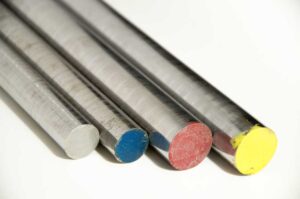Achieving Efficiency: The Role of Tool Steel in Energy Sector
 Safe, reliable energy depends on advanced materials that withstand extreme environments. Tool steels fill this crucial role across the energy sector, from drilling miles into the earth to harnessing the power of wind and sun. Their unique properties allow fabricating, machining, and maintaining equipment that extracts and transports resources with new levels of efficiency.
Safe, reliable energy depends on advanced materials that withstand extreme environments. Tool steels fill this crucial role across the energy sector, from drilling miles into the earth to harnessing the power of wind and sun. Their unique properties allow fabricating, machining, and maintaining equipment that extracts and transports resources with new levels of efficiency.
In this article, we’ll explore the indispensable role of tool steels enabling innovations across the energy industry. Discover how specialty alloys improve the efficiency and durability of drills, turbines, reactors, and massive components that power civilization. Without tool steel’s contributions, energy technologies would remain confined to the drawing board rather than transforming how we harvest and utilize resources.
An Introduction to Tool Steels in Energy
Tool steels refer to the family of specialty carbon and alloy steels engineered for machining, pressing, casting, and abrasion resistance applications. Key attributes like hardness, wear resistance, and thermal properties make them vital across energy:
- Strength and fracture toughness to withstand heavy forces
- Hardness to resist wear from abrasive rock or corrosive fluids
- Dimensional stability across repeated heating cycles
- Resistance to fatigue, creep, and cracking over prolonged use
- Capability to be precision machined into intricate components
These characteristics allow fabricating specialized parts and equipment able to reliably withstand the world’s most punishing conditions for decades on end. Tool steels build the foundation of our energy infrastructure.
Extreme Drilling Demands Extreme Materials
Extracting oil, natural gas, geothermal energy, and minerals from miles underground is only possible using precision equipment forged from the most durable alloys. Tool steels enable drilling milestones:
Drill Bits
Cutting through mile-thick layers of shale, sandstone, limestone, and granite wears down lesser metals quickly. But ultra-hard drill heads incorporating industrial diamond or tungsten carbide inserts withstand the abrasion and high temperatures to penetrate deep zones previously inaccessible.
Drill Pipe
Miles of steel drill pipe channel drilling mud and transmit torque to the bit. Specialty tool steel compositions resist cracking from repeated bending strains. Hardchrome plating provides wear protection from abrasive mud and rock.
Downhole Tools
Tool steel creates mud motors that turn bits independently of the pipe rotation. Directional drilling depends on tool steel stabilizers, reamers, and drill collars that steer the bit with precision. Durability in hot, high-pressure conditions enables accessing far-reaching energy deposits.
Without tool steels able to handle the heat, pressure, and abrasion of drilling miles into the crust, the world’s energy resources would remain largely untapped.
Giant Components for Gargantuan Equipment
Massive turbines, reactors, engines, and rigs depend on enormous tool steel components carefully shaped to fine tolerances. Only tool steel combines the needed strength, toughness, and machinability on such a large scale.
- Turbine shafts 12 feet in diameter rely on the stability and fatigue resistance of forged tool steel able to rotate precisely for decades without cracking or distorting. The same durability applies to gears, fasteners, and housings.
- Tool steel boring bars boring bars, rasps, and grinders shape massive reactor vessels with wall sections over a foot thick. Preventing tool failure when machining such large parts requires materials with high productivity and reliability.
- Die sets weighing hundreds of tons forge and mold enormous steel parts for engines and rigs. Only the hardest tool steels withstand such extreme pressures and last for thousands of cycles forming super-sized components.
- Hydraulic cylinders several meters in diameter trust tool steel pins, shafts, bearings, and seals to withstand titanic water forces for hydroelectric power.
No other material combines the needed strength, toughness, and workability on such a colossal scale. This enables the gargantuan equipment driving the energy sector.
Safe, Durable Pipelines
Transporting oil, gas, chemicals, and water safely over long distances depends on durable pipelines resistant to corrosion, fatigue, and cracking. Tool steels make this possible through:
Pipe Manufacturing
Rolling, drawing, extruding, and machining tool steel constructs precision pipe able to meet the harshest service demands. Pipe molds, dies, and mandrels require tool steel’s dimensional precision across thousands of miles of pipe.
Valves and Fittings
Highly engineered tool steel valves, connectors, elbows, tees, and reducers maintain tight seals and withstand millions of duty cycles over decades of service. This controls flow safely.
Maintenance and Repair
Reaming, milling, grinding, and cutting worn pipe relies on durable tool steel equipment to remove damage and restore dimensions for continued service. Portability and reliability are vital during repair work.
From mills to pumps to treatment facilities, tool steel empowers smoothly running pipelines that delivers resources safely and with minimal losses.
Harnessing Wind, Water, and Sun
Even renewable energy depends on tool steels to capture power consistently and reliably on an industrial scale. Their unique properties aid performance and durability:
Wind Turbines
Gearboxes, jackshafts, couplings, rotors, and blade components experience millions of rotation cycles under high centrifugal forces. Tool steels provide the fatigue strength, fracture toughness, and dimensional precision vital to reliable, lasting power.
Hydroelectric Plants
Generating consistent, clean power requires tool steel turbine runners, retaining rings, wicket gates, and components that maintain integrity across decades of water exposure. Preventing erosion and corrosion keeps efficiency high.
Concentrated Solar Plants
Solar collection and steam generation demands specialized tool steels able to withstand concentrated heat and thermal cycling. This allows achieving higher temperatures and efficiencies than conventional materials allow.
Whether extracting fossil fuels or harnessing renewables, tool steels enable energy harvesting that performs consistently and safely even under the world’s most extreme conditions. No other material unlocks such capabilities.
Future Energy Frontiers
 As energy evolves to power society more cleanly and efficiently, tool steels will remain indispensable across sectors:
As energy evolves to power society more cleanly and efficiently, tool steels will remain indispensable across sectors:
Geothermal
Advanced drilling technologies promise to unlock cleaner geothermal energy. But accessing deeper hot zones hundreds of degrees hotter will test tool steel limits.
Small Modular Reactors
Compact nuclear reactors depend on nano-engineered tool steel components with extreme radiation resistance and reliability. Quality control minimizes risks.
Grid Modernization
Upgrading aging transmission networks involves larger, more durable towers, connectors, transformers, and buried cables relying on tool steel performance.
Energy Storage
Next generation batteries, capacitors, and flywheels require new tooling solutions as researchers experiment with new chemistries, processes, and materials.
Carbon Capture
Efficient systems to capture and sequester carbon emissions will demand specialty tool steel solutions able to withstand the high pressures and corrosion.
Just as in the past, tool steels will support unlocking emerging innovations that safely and sustainably power the future. The material sits at the leading edge.
Key Takeaways on Tool Steels in Energy
Tool steels fulfill indispensable roles across energy:
- Hard, wear-resistant grades enable extreme drilling tools and technologies to access new reserves deeper than ever.
- Massive strength and machinability allow fabricating enormous components at the heart of turbines, reactors, engines, and rigs.
- Fatigue and corrosion resistance craft pipelines and valves transporting resources safely and with minimal losses.
- Renewables like wind, hydroelectric, and solar depend on tool steel reliability harnessing natural power consistently.
- As energy evolves, new specialty tool steels will overcome challenges and expand possibilities in generation, transmission, and storage.
Without tool steel, the feats of engineering providing society heat, light, transportation, and electricity would simply not be possible. The metal empowers innovations that energize the world.
FAQ
How are tool steels used in drilling operations?
Tool steels are critical in equipment like:
- Ultra-hard drill bits to cut through rock
- Drill pipe that withstands bending strains
- Downhole mud motors, stabilizers, reamers
- Components tolerating heat, pressure, and abrasion
These innovations allow drilling deeper to access new energy reserves.
Where do tool steels enable large-scale energy equipment?
Giant turbines, engines, reactors, rigs, and hydroelectric dams depend on massive tool steel:
- Shafts, gears, fasteners, and housing components
- Boring bars and tooling machining thick sections
- Enormous die sets for forging giant parts
- Hydraulic cylinder pins, rods, seals tolerating extreme pressures
How do tool steels aid safety and efficiency in pipelines?
Tool steels allow:
- Smooth pipe rolling, drawing, extrusion, and machining
- Durable valves, elbows, connectors that maintain seals through millions of cycles
- In-field repair and restoration of damaged pipe sections
This maximizes flow volumes with minimal losses or hazards.
Where are tool steels critical in renewable energy equipment?
Wind turbines, hydroelectric generators, concentrated solar plants, and more utilize tool steels for:
- Gearboxes, rotors, couplings, jackshafts seeing constant loading
- Turbine runners and wicket gates resisting water forces
- Durable collectors and tubing handling concentrated heat
Reliability even under extremes allows maximizing clean energy.
How will tool steels aid emerging energy innovations?
Future energy frontiers will demand new tool steel solutions for:
- Advanced geothermal drilling equipment
- Miniature nuclear reactor components
- Large power grid upgrades
- Next-gen batteries, capacitors, and flywheels
- Carbon capture systems tolerating high pressures
Tool steels enable translating new concepts into working technologies.

